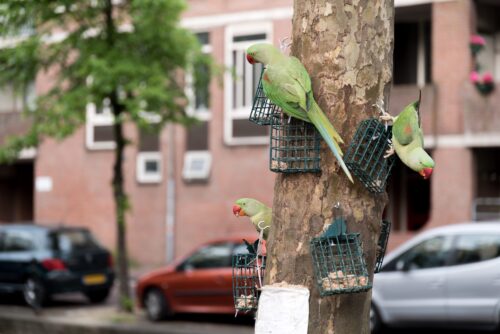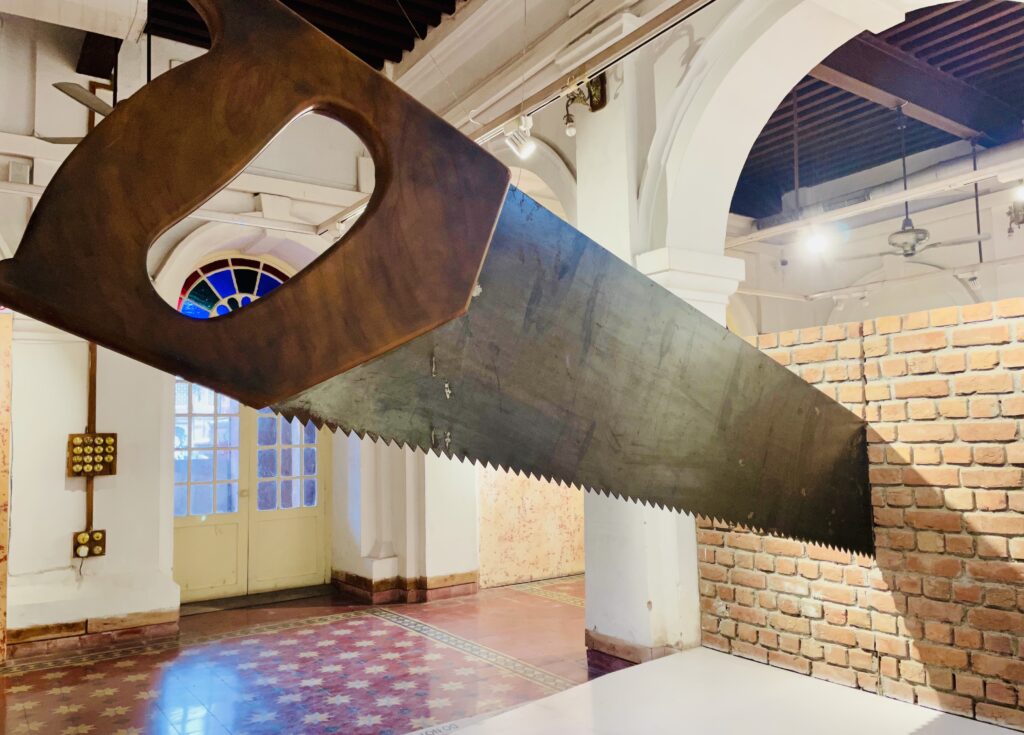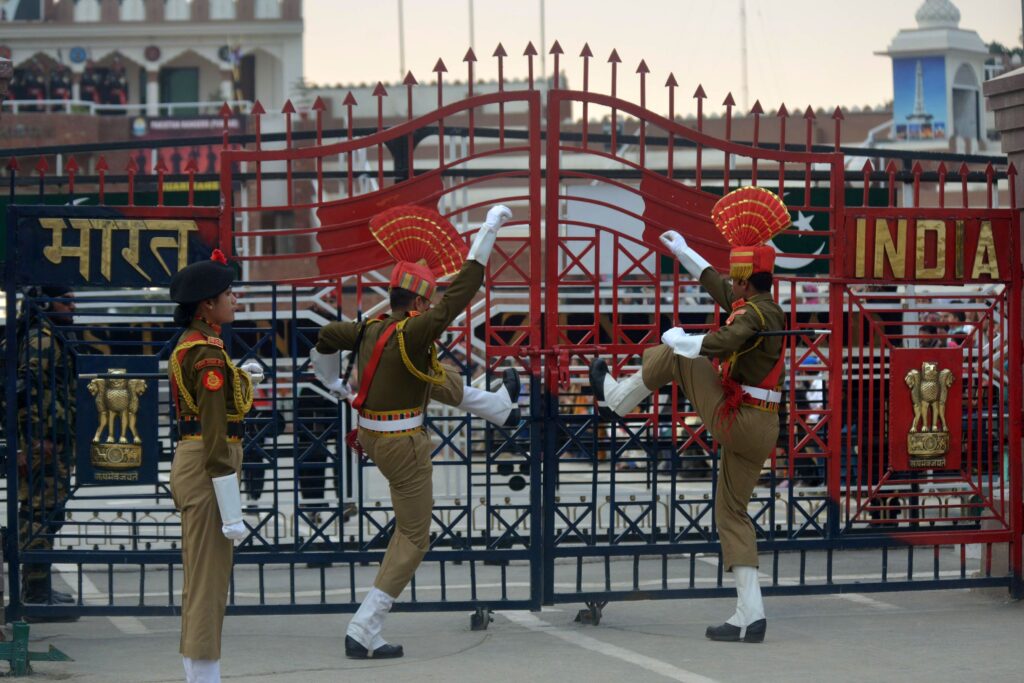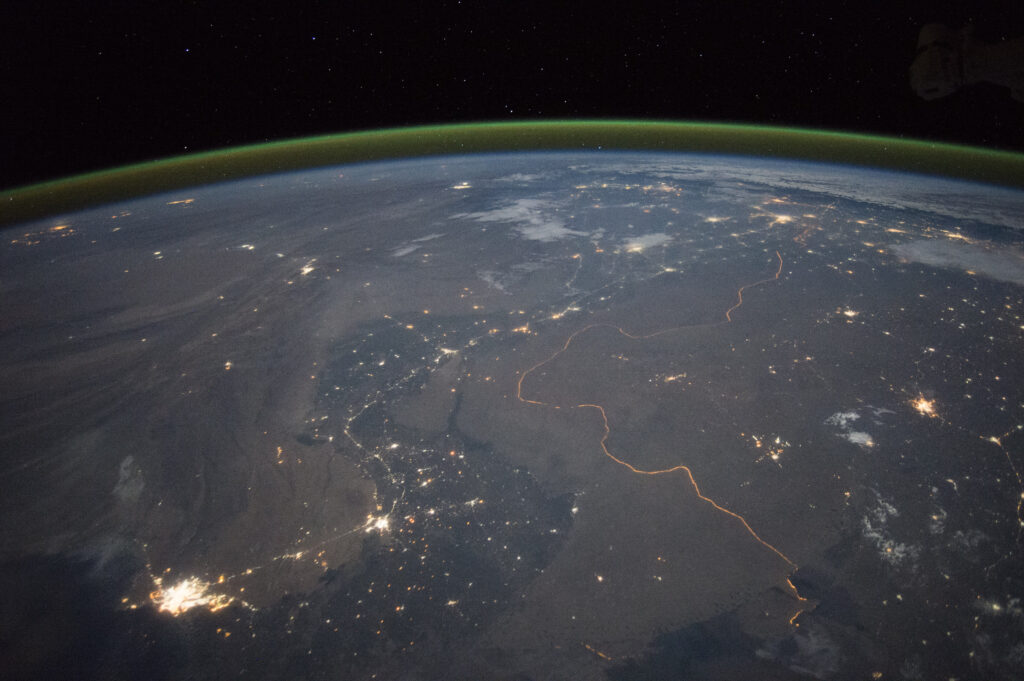Imagining Other Worlds at the India-Pakistan Border
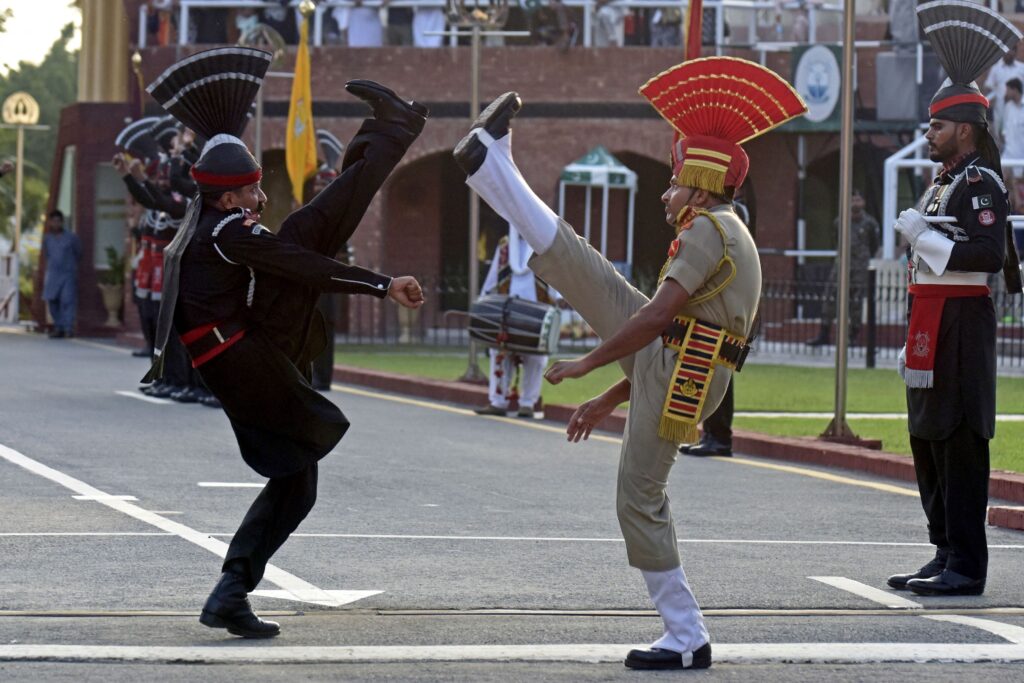
There are two main ways to experience the border between India and Pakistan at Wagah: You can cross it through the trade route if you’re a trucker delivering goods or you’ve managed to secure a visa to enter—a difficult if not impossible task for most Indians or Pakistanis. [1] [1] The Indian government changed the border name to Attari in 2007, but colloquially people on both sides of the border still refer to it as Wagah. Or, you can attend the daily border ceremony, where soldiers on either side meet to lower their countries’ flags in an elaborate display of military pageantry.
From the India side, I head to the border ceremony, arriving first at a multilevel concrete parking structure. The anticipation builds as I get out of a taxi and join the droves walking from the parking lot to a football-like stadium.
It’s July 2022, and in a few weeks, both countries will celebrate their 75th anniversaries of independence from British colonial rule. The year 1947 also infamously marked the partitioning of the subcontinent, when British lawyer Sir Cyril Radcliffe drew a line on a map that sliced through the states of Punjab in the northwest and Bengal to the east. The actual movement of people across the borders happened between June and September 1947, spurred by news, rumor, violence, and disbelief. It was a top-down political division that took people who found themselves on the wrong side of the new border by surprise.
The Partition of India is considered one of the largest forced migrations in world history. Over 15 million made the journey, including members of my own family. Approximately half were Muslims crossing into Pakistan and roughly the same number were Hindus and Sikhs crossing into India. More than 1 million died or were killed along the way, and 75,000 women were abducted and raped.
You could say the crossing itself—violent and disorienting—brought the two countries into being.
I file into the stadium, expecting a somber affair. But the Indian Border Security Force guards stationed along the way seem surprisingly relaxed and friendly. Once I pass through security and reach the stadium grounds, the mood is lively. Vendors hawk chips, popcorn, and mini cartons of lassi and cold coffee. Fans, flags, and hats proclaim, “I Love My India.” People line up to have their faces painted with the tricolor Indian flag.
Inside, I’m overwhelmed by how loud it is: a mix of cheering, yelling, and marching orders alongside a never-ending soundtrack of national anthems and Hindi film songs. The crowd on my side of the stadium—mostly Indians but from all over the region, country, and world— shouts, “Hindustan Zindabad!” (Long Live India!).
From high in the stadium, I look down to see a sliding metal gate with open grills and pillars festooned with the emblems and flags of each country. On the other side, there’s a large image of Pakistan’s founder, Muhammad Ali Jinnah, next to our Pakistani counterparts in their own stands. They’re speaking Punjabi and Urdu, no doubt. Their chant rings, “Pakistan Zindabad!” (Long Live Pakistan!). But they’re sitting under the same blue sky and blazing sun as we are, and they look like us.
Eventually, the beating retreat ceremony, as it’s called, begins. Soldiers from the Indian and Pakistan sides of the border come out. They bow and march this way and that with regulation high-kicks into the air. Emcees direct the crowd when to cheer. The two nuclear-armed nations, I realize, are putting on a halftime show on steroids.
I find myself yelling along, caught up in the energy of the crowd. Still, it’s hard to know what I’m cheering for. My own relatives had crossed this space around the time of Partition in 1947; now I’m sitting here as if at a picnic.
The day before, 25 kilometers away in Amritsar, I had visited the new Partition Museum—the first of its kind. It contains documents, photos, belongings, and eyewitness accounts in the form of video interviews with people who lived through Partition and its aftermath.
At the museum, I was most struck by an interview with Pushpindar Singh Chopra. His father was one of the two men who made the border at Wagah—the actual physical markings on the landscape, not the border drawn on a political map by Radcliffe.
In a moment, the city of Amritsar, Chopra explained, went from being “in the middle of India” to being “a border town” near Pakistan. He recounted the story of his father, Brigadier Mohinder Singh Chopra, calling up his counterpart in Lahore (Amritsar’s sister city until Partition), Nasir Ahmed. The two men had been in the same Indian army and regiment up until Partition. They agreed to meet on October 11, 1947, the day they would trace the border together—through people’s homes and properties.
One of my great aunts who lived near Lahore at that time told me about having left her house with only a katori (small bowl) and spoon. She had assumed she would soon be back home, maybe just after a few meals. Instead, she ended up as a refugee in Delhi, never to go back.
My maternal grandfather crisscrossed the border several times in the months before Partition. More than once, he moved his family back and forth, including my mother, who was 4 years old at the time. Until Partition happened, it was something people could not believe was going to happen. Everyone initially thought of eventually going back to where they’d come from. My grandfather went back to Lahore by himself as late as July of 1947 to get important items he’d left, only to get stuck in riots. He was helped by Muslim neighbors to make his final crossing by train, first to Amritsar and then to Delhi.
Even today, the border remains a powerful reminder of state violence. Growing up with stories of my family’s displacement during Partition fueled my disdain for nationalism—in the region or anywhere in the world. I fear history is repeating itself today, as I see the way Muslims in India have been vilified during the Hindu nationalist Modi regime of the last nine years.
Nationalism always requires the casual or orchestrated demonization of other people and groups, often within one’s own country—and certainly toward those on the other side of the border.
Anthropologist Miriam Ticktin has argued that border designs “embed their own political imaginaries.” In other words, they tell their own versions of history—and express ideas about a nation’s future. I see the Wagah border post in this way. It does not encapsulate the meaning of the entire Indo-Pakistani border. Rather, it is a place to imagine otherwise.
That day at Wagah, I’m not cheering for India but for peace between India and Pakistan, I tell myself. I had been to Pakistan before (made easier by the fact of my U.S. citizenship), so I didn’t just have to gaze across the gate and imagine what it was like. I have friends there and had an extremely warm welcome when I gave a talk at the University of Karachi a few years earlier.
The best part of the ceremony is when the gates open and the Indian and Pakistani soldiers, in their plumed turbans, meet and shake hands. That’s when you realize they must have choreographed and practiced the whole ceremony together. Despite the nationalist fervor in the air, the stadium is also a rare space where crowds of Indian and Pakistani civilians can come face to face.
My mind drifts to an image of these soldiers on both sides waiting around for instructions, chatting among themselves, maybe even having chai together. Could it be a script for the future?
In the stands, people are cheering. They are also getting drinks and adjusting themselves and tending to children. This ceremony has been going on for decades, with only a few pauses when tensions between the two nations have been particularly high. Even after a suicide bombing on the Pakistani side in 2014 that killed more than 50 people, the ceremony went on the next day. It proceeded in defiance of the militant groups who took responsibility for the attack—at the request of both sides.
The border is an idea so powerful we never even have to see it to believe it. We know it exists and that’s enough; we act accordingly. But a border is not only a place that divides. It’s also a place that generates its own meanings and experiences, some of which might contradict the ideas behind it.
In the end, it is not cultural or even political difference that is enacted at the Wagah border but a kind of bridge between the two countries. It’s a reminder of how one colonial history creates two hostile nation-states; after all, the beating retreat ceremony has British military origins. But in its present-day incarnation, the ceremony is also a surprisingly enjoyable farce, enacted again and again for thousands of spectators, connecting both sides.
Unlike the two-hour buildup before the border ceremony, once the flags are down and the gates closed, it is all over. We quickly file out of the stadium.
Driving back to Amritsar as the sky darkens around us, I can’t help but imagine an alternative ending: The gates close as they must. But then we on the India side all go around the façade of the border, behind the scenes to the “other side.” Maybe there are banquet tables set up with platters of biryani and small plates of raw onions and green chiles. Maybe we all eat together—raat ke aasmaan ke tale, under the night sky.





























